"Black holes, which have no memory, are said to contain the earliest memories of the universe, and the most recent, too, while at the same time obliterating all memory by obliterating all its embodiments. Such paradoxes characterize these strange galactic monsters, for whom creation is destruction, death life, chaos order." -Robert Coover
Our Milky Way, the swath of light and dark that dominates the darkest skies here on Earth, contains a huge variety of stars: large and small, red and blue, from young to old to ancient.
But the very center of our galaxy contains, deep within its heart, one object that's unlike any other. Completely dark in the visible part of the light spectrum, due to the neutral gas and dust that prevent the light from getting through, we can successfully peer through to the center of the galaxy only in very specific wavelengths, and only from space.
When we do so, one region stands out from all the others, no matter how we look.
That bright region, outshining all the others in each wavelength? That's the innermost, supremely central region of the Milky Way. If we take our highest-resolution telescope, in the wavelengths most transparent to light, what do we find in this central region?
In short: a mess. Thousands upon thousands of stars crowded into a region of space that -- if it were of our local neighborhood instead -- would contain only our Sun.
Yet at one very small, special location, known as Sagittarius A*, an incredibly bright radio source lives among the young, hot, but otherwise relatively normal stars.
What's going on in that region marked by those two yellow arrows? The stars there are orbiting something with incredible speeds, something that, according to the known laws of gravity, is millions of times the mass of the Sun.
Oh, and also, it emits no light. That, my friends, is how we know we have a supermassive black hole at the center of our galaxy. It turns out that practically every galaxy has one, and the larger the galactic bulge, the larger the black hole at the center.
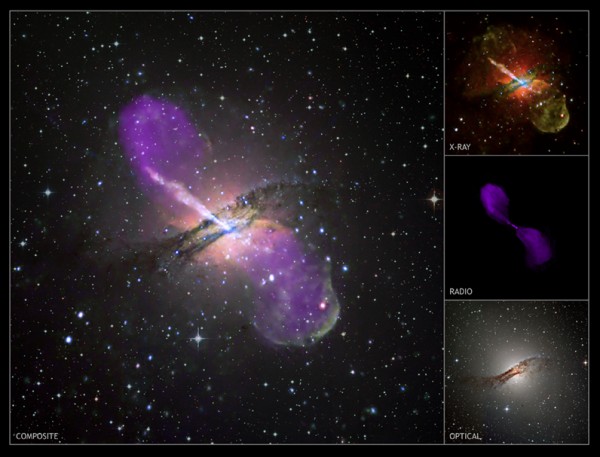
Composite image credit: X-ray - NASA, CXC, R.Kraft et al.; Radio - NSF, VLA, M.Hardcastle et al.; Optical - ESO, M.Rejkuba et al.
Most supermassive black holes are dormant -- or not active -- most of the time, and thus, like our own, are very difficult to detect. But looking deep into the Universe with the Chandra X-ray telescope, we were able to see a large number of active supermassive black holes.
When we extrapolate what we see here to the entire Universe, we find that about 300 million supermassive black holes are active and pointed at us at any given time.
That correlation of bulge-size to black hole mass is a good one, and there are only three known exceptions: one is when a merger kicks a black hole out of a galaxy, one is when a galaxy has some of its mass stripped away, as in the case of the galaxies below...
and perhaps most bizarrely, one is in the very early stages of the Universe, when the earliest supermassive black holes are more massive than you'd naïvely expect they would be. I was recently asked about this, and it is a very good question. So why do these supermassive black holes form, and why do they grow so massive so quickly?
After all, when we see supernovae, if they create a black hole at all, they only create a black hole that's a few times the mass of our Sun.
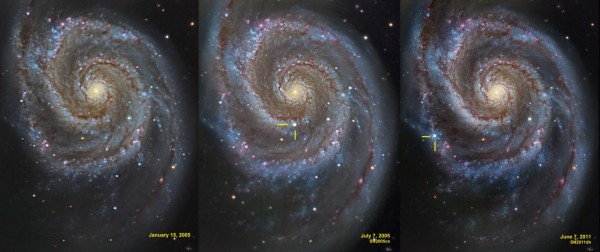
Image credit: R Jay Gabany of http://www.cosmotography.com/.
Maybe the largest supernovae we've ever seen created a black hole 20 or 30 times as massive as our Sun, but that hardly explains how we get up to millions or (in the largest cases) billions of solar-mass black holes.
To understand how this happens, I need to you imagine all the way back to the early stages of the Universe: before our Solar System existed, before large clusters of galaxies merged and formed, before generations of stars lived and died, before even the first clouds of gas and dust collapsed to form stars. Imagine back to when the Universe was relatively uniform, dark, and only beginning to have the most overdense regions begin to contract down, where they will eventually form the very first stars in the Universe.
Eventually, the hydrogen and helium gases in the densest locations achieve high enough densities to ignite the first nuclear fusion reactions, causing stellar burning and star formation for the very first time. This is a Universe containing maybe 1023 solar masses worth of hydrogen and helium, and the very first locations that are lucky to form stars will do it in chunks that range from many millions of solar masses down to may be as small as a few hundred thousand times the mass of our Sun.
But it is these most massive stars that are most interesting: the hottest, brightest, bluest and also shortest lived, these are the stars that will form heavy elements in their core (allowing for the eventual formation of planets), go supernova (enriching the Universe), and -- in certain cases -- collapse to form black holes.
But it is the most extreme stars -- the ones that are over 130 times the mass of our Sun -- that are the most interesting as far as forming a supermassive black hole goes. Sure, less massive stars can form smaller black holes, but once you get above 130 masses, the interior of your star becomes so hot and energetic that the highest-energy radiation particles you create can form matter-antimatter pairs, which create an instability in the star that wind up blowing the entire thing into smithereens!
Of course, this doesn't help you create a supermassive black hole at all, does it?
The thing is, this is only true for stars with masses above 130 solar masses and below 250 solar masses. If we get even more massive than that, we begin to create gamma rays that are so energetic that they cause photodisintegration, where these gamma rays cool down the interior of the star by blowing the heavy nuclei back apart into light (helium and hydrogen) elements.
In a star with more than 250 Solar Masses, it simply collapses entirely into a black hole. A 260 solar mass star would create a 260 solar mass black hole, a 1000 solar mass star would make a 1000 solar mass black hole, etc.
The question, of course, is do we actually make these, and do we make them in abundance that it's reasonable they would grow to form early supermassive black holes? To answer this, we turn to the largest star-forming region in our wimpy local group: the Tarantula Nebula located in the Large Magellanic Cloud.
This region of space is nearly 1000 light years across, with the massive star-forming region in the center -- R136 -- containing about 450,000 solar masses worth of new stars. This entire complex is active, forming new, massive stars.
It should be no surprise that our most recent, close supernova -- SN 1987a -- originated on the outskirts of the Tarantula nebula.
But it's not the outskirts, but the central, R136 region that is most spectacular. Let's dive right in to the hot, bright blue stars.
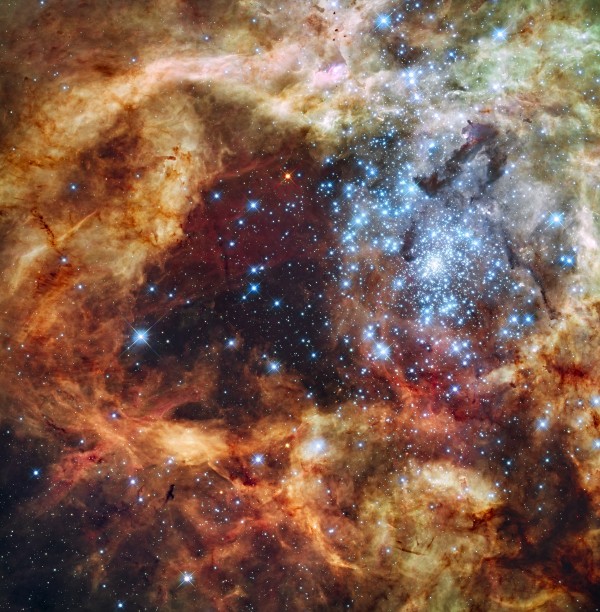
Image credit: NASA, ESA, & F. Paresce (INAF-IASF), R. O'Connell (U. Virginia), & the HST WFC3 Science Oversight Committee.
You may notice, right away, that there's one bright star that isn't blue at all, but rather red. This is an important star that may, in fact, become our night sky's next supernova.
But this red giant, even if it forms a black hole, won't form a very massive one. Remember, we're on the lookout for stars with masses over 250 times the mass of our Sun.
The amazing thing is this: there is one in here!
The most massive star known to humanity, R136a1, weighs in at 265 solar masses, and if its core gives out right now, it will collapse immediately to a black hole of 265 solar masses! This star, in particular, may not do that because of the heavy elements present, but in the early Universe, there are no heavy elements present, and so all stars above this mass threshold will simply get converted into black holes!
Because of how galaxies are thought to form in the early Universe -- by the rapid merger and accretion of collapsed, star-forming regions -- it's unthinkable that these early, large black holes wouldn't merge with one another and grow, forming increasingly larger and larger black holes at the centers of these objects: the Universe's first large galaxies.
If we can get just one 250 solar mass black hole for every 500,000 solar masses worth of stars, that means by time we get up to a Milky Way-sized galaxy, with maybe 2-400 billion solar masses worth of stars, we'd expect a central supermassive black hole of 100-200 million solar masses! This is exactly the type of growth we need to create the largest of the supermassive black holes we observe today, and we've got the evidence that the right type of stars form right in our own backyard.
So that's where the earliest supermassive black holes come from, and I hope you enjoyed your journey through time, space, stars and the elements: they brought you the Universe you get to have today!

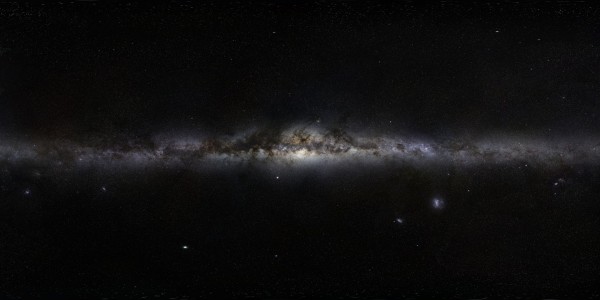
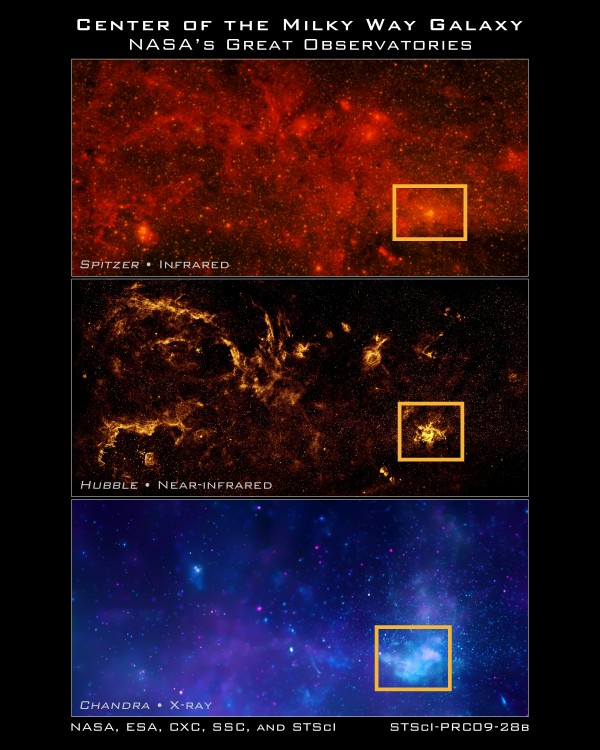
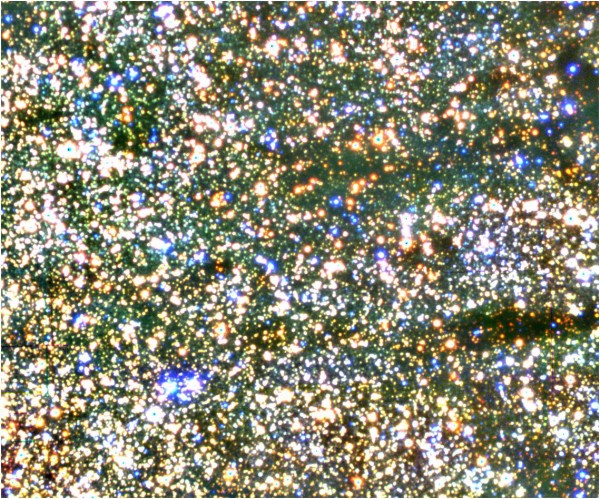
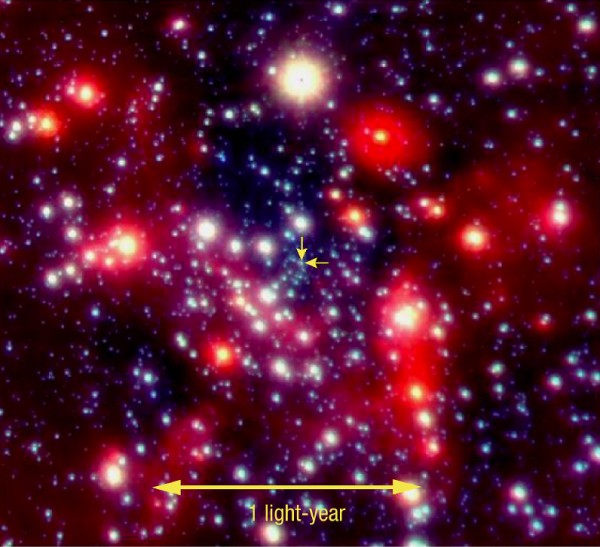
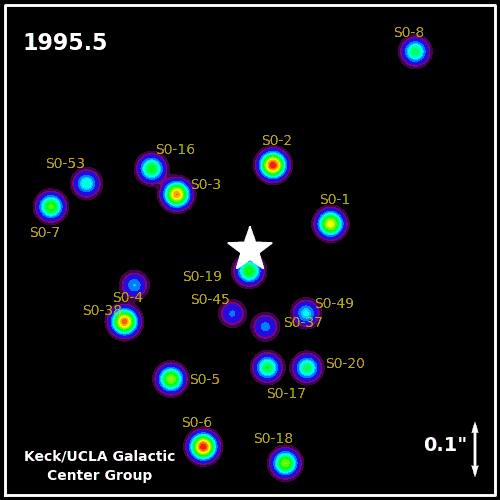
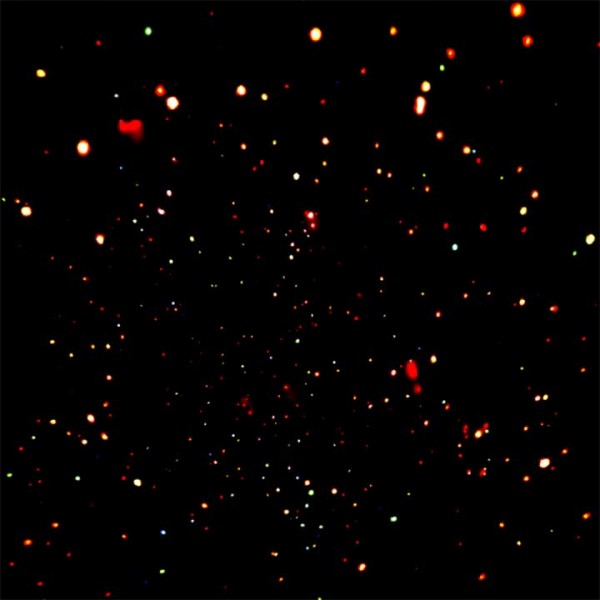
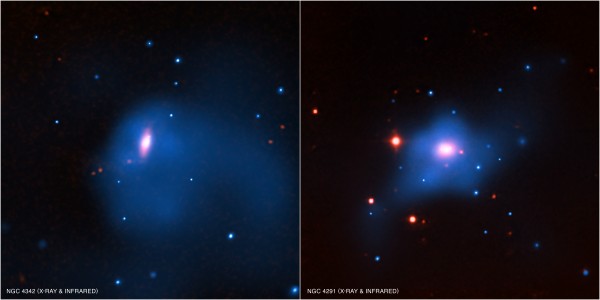
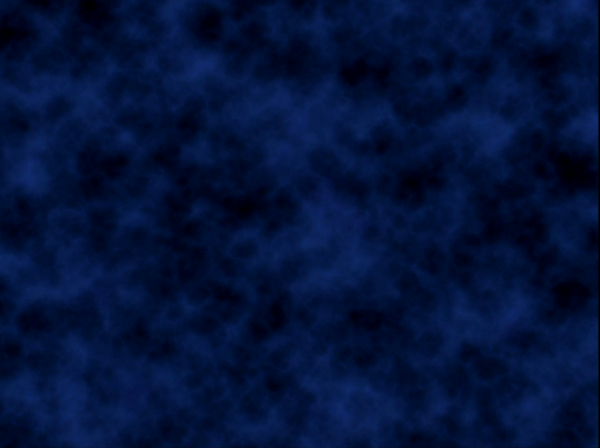
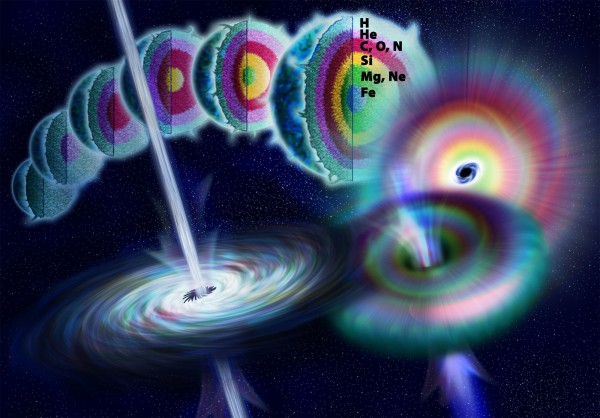
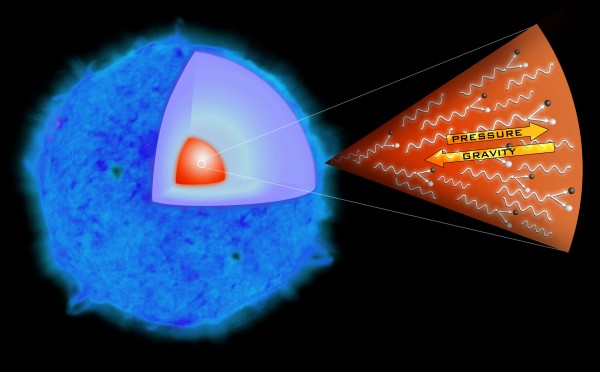
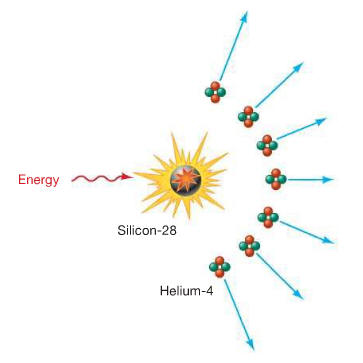

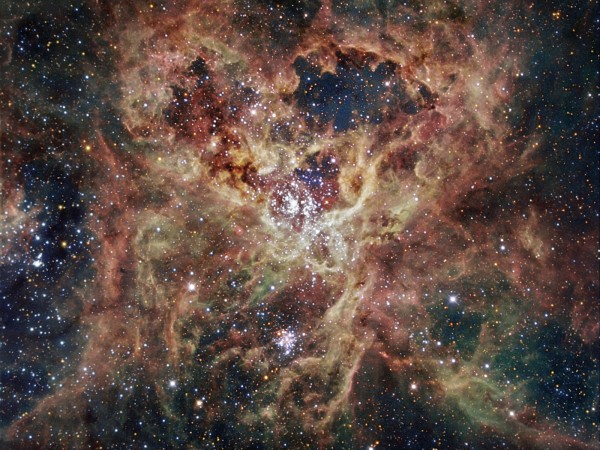
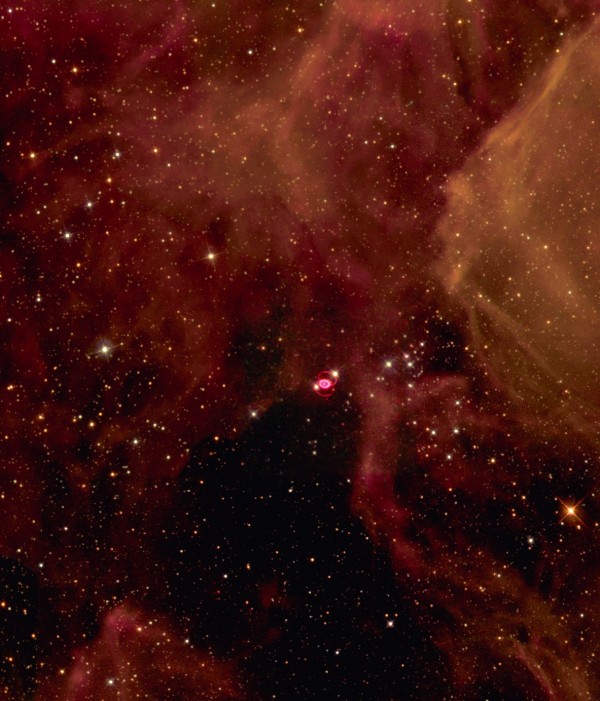
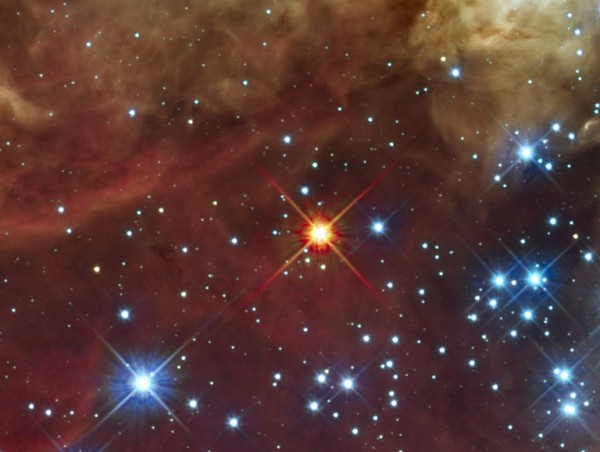
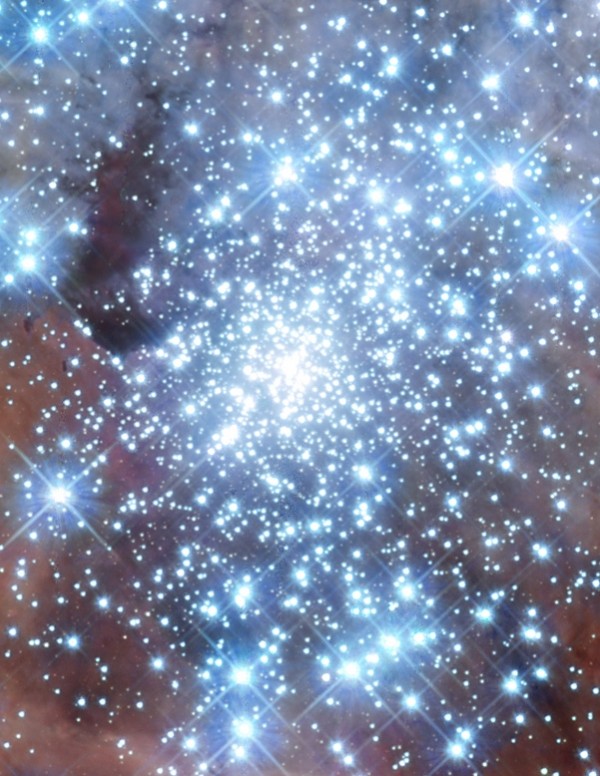
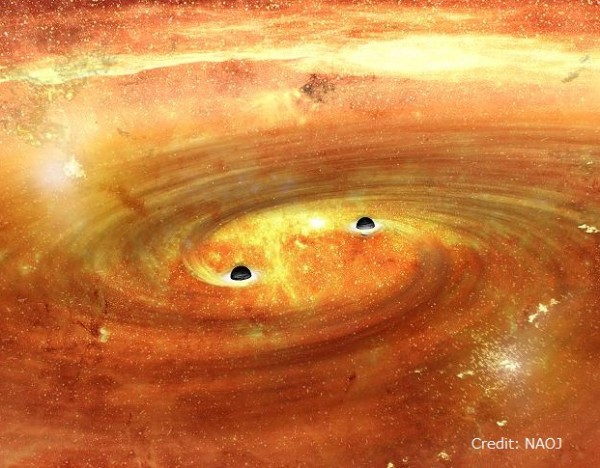
In the picture with the three views (x-ray, near infrared, and infrared) there's another interesting region off on the left that's kind of box shaped. Any idea what that is? It's one of the few regions that also seems strong in all three.
Wow, I thought the supermassive black holes were just the first in the bunch, who got lucky to eat all neighbouring matter and grew to enourmous scales. I can't picture two black holes merging, what would it seems like?
That KECK-animated gif is too dodgy to be taken serious as proof for a Black Hole. Here is a video of how they found the spot:
http://www.youtube.com/watch?v=E-BM5_JyTeY
One picometer 'off-target' and 'our' view would have been blocked by some other star. Being able to capture this 'action' is almost the same chance as winning the lottery.
And the starts that seem to be twirling around that one spot, are just too vague to judge if they are in that specific area, and what their path is. This looks like a fraud ... emperor's new clothes.
The supermarket.
Easy.
The supermarket.
Easy.
The supermarket.
Easy.
Ethan - just let me thank you for doing such a GREAT job. Your content is comprehensive, accessible and sooo enlightening. I've been doing this astro thing for over 45 years and think myself relatively well informed (for an amateur), but you nearly always surprise me.
Hello Mr. Siegel! I have one question for you, if you don't mind. You said "Most supermassive black holes are dormant".... How can that be? How can a black hole not be active?
Thanks!
-Chelsea
Hmmm.
The site commenting system seems a little borken.
Post didn't appear. Tried under a fake ID to see if it were rate limiting, but that didn't appear either.
It looks like just this one.
That multipost wasn't me. The comment system is borked!
Chelsea- the difference between active & dormant is whether it's eating something or not. Our central black hole seems to have cleared the space immediately around it, so it's considered dormant. No ionized jets are visible. In other galaxies, we can see huge emissions from their cores, with spectacular jets shooting thousands of light years into space. I believe there were recent observations of one that indicated it had just eaten a whole star. Sorry I can't recall where it was, maybe Ethan knows?
Speaking of site problems, I push the Subscribe - RSS button at the top, but the reader says "no articles" and I never get any. It's been like that since the recent move. I'm running Safari over Lion on a MacBook Pro.
On topic, what might happen to these black holes as inflation accelerates? Will they rip apart?
@chelle: The "Keck animated video" Ethan posted is not an "artist's conception," and neither is some of the video you cited. They are both _real_data_!
The color coding indicates the signal intensity from the pixels of their CCD (the circles show you how much the point-like stars are smeared out when you look at them, which is called the "point spread function").
In your video, the boxed plot from 0:56 to 1:27 is exactly the same data, but shown in grey-scale rather than false color. Those are actual pictures of actual stars within ~3 lightyears of Sgr A*, not a cartoon.
We know that these stars are all orbiting a common point because we can _watch_ them, over the course of about a decade, and use that information to fit their orbital parameters. They are all following very nice Keplerian orbits around a central point, just like the planets, asteroids, and comets in our solar system.
Here are some links to papers with the actual research behind that very nice video you posted.
A good general review: http://arxiv.org/abs/1006.0064
The gas cloud G2, tidally disrupted and possibly on a capture orbit: http://arxiv.org/abs/1112.3264, http://arxiv.org/abs/1201.1414, http://arxiv.org/abs/1207.4215
The close-in star S2: http://arxiv.org/abs/0910.3069
You can find a lot of really good papers on different aspects of Sgr A*, including discussions of near future _direct_ observations of the central SMBH, by searching arXiv for "Sgr A" in quotes, http://arxiv.org/find/all/1/all:+EXACT+Sgr_A/0/1/0/all/0/1
Michael,
I'm not saying that this animated gif nor the video is an 'artist’s conception' they are real alright. I only question the claims of it being stars circulating da black hole in the center of our Milky Way. Like I said the chance of being able to look at precisely THIS area is about one in a million. Haven't you seen how the detection of this spot is a continuous zooming-in between thousands of other stars, ... just a tiny fraction to the side and we would be able to see it. Could we really be this lucky, is what I ask myself. Second the imagery is so vague that with some ingenious visual enhancements you can make it look as if they're all in that confinement of space, it makes me think of an illusion done by David Copperfield. And yes the papers are very nice, it is only that the visual proof doesn't look sufficient enough. Maybe I've been fooled too many times (once) in my life that I have become too skeptical about things that look too good to be true. If you like to take this as valid proof, than that you are entitled to do so, but I'm not very convinced. Also I'd like to see what is there to see in a section next to this one and compare, and if all around that particular spot there is nothing going on well than you might have convinced me, but not this early in the game.
One more thing, I also would like to compare it to an N-body simulation and the gravity interaction of a few stars closely packed together and given a group rotational velocity without a 'black hole' near it. It might produce the same type of stellar dance.
OMG, RSS has been fixed ALREADY! Thanks, whoever...
Dr. Siegel -- I wish to thank you for writing these wonderful explanations of the universe. You know how to hold my attention. Thank you, Robert Buckley
Well.that answered my question about the center of the galaxy.
Chelle, the mass of the object orbiting is given by the valocity of the stars orbiting. The size is given by the shape of the orbit.
The density resulting csnnot be reasonably be explained by stellar objects.
Additionally, the brightness of a suitable cluster central mass if stellar in origin (remember stephan's law) would be readily discernable.
Stars don't cut it.
Wow, I'm not going to argue about the fact if there is or isn't a Black-Hole in the center of our Milky Way or any other galaxy. We've already had a lot of debating regarding this point and I respect your opinion.
I'm only focusing here on the 'proof' of that KECK-gif and YouTube-video. Look at it again as of 0:55
I have cut that part out and transformed it into a .gif-file:
http://www.freeimagehosting.net/newuploads/kqjiu.gif (1.4 Mb)
Look how the timeline goes up from 2004 up to 2011, and back down to 2002. This creates the illusion that those stars are making some Kepler loops. Yes, they have put the years next to it, but along with some soothing music and some extra more impressive visuals, you are in a way misleading spectators and creating an illusion, covering up the weakness of the proof.
Maybe the YouTube material is very vague due to uploading, but transforming it into the 'precise' KECK-gif-animation that Ethan presents here on the blog, seems to be a too presumptuous leap to me. All this along with the one in a million chance of capturing it, leaves me with no other option than to conclude that it is probably a fraud.
Well why don't you go and simulate the N-body problem blah blah blah and answer your question?
@Chelle
what are saying man? You think that youtube video is a proof for black holes??? That's just a nicely presented summary of piles and piles of data and analasys bundled down to 1:50 mins or so...
You say that couple of images don't proove it. ANd they don't. But you're the only one who seems to think that's all there is to it. Did you even bother looking at the papers mr. Kelsey linked to you? My bet is you didn't. And you were even arogant enough to dismiss them with a slight of a hand. Saying: "And yes the papers are very nice, it is only that the visual proof doesn’t look sufficient enough."
Go and read those papers, and if you still disagree, put valid questions and doubts about the methodology with specific issues if you can, instead of bashing some ppl for making a cool animation based on data.
What the hell do you want anyways?
> "why don’t you go and simulate the N-body problem
http://en.wikipedia.org/wiki/N-body_problem
Sinisa,
Check this article:
http://www.nature.com/nature/journal/v455/n7209/full/nature07245.html
It clearly states that Sgr A* is located off-center from the suggested supermassive black hole that would be at the center of our galaxy. The 'proof' from KECK appears to be no good.
> "What the hell do you want anyways?"
I do like to be entertained when I go see a movie or a have a laugh with my friends, but when it comes to science I prefer the truth.
@Chelle
"It clearly states that Sgr A* is located off-center from the suggested supermassive black hole that would be at the center of our galaxy. The ‘proof’ from KECK appears to be no good."
mmmm... NO!
You either missread the paper that you linked just now, or you do not understand what they are saying.
Quote from the paper you linked: "...suggesting that the bulk of Sgr A* emission may not be centred on the black hole, but arises in the surrounding accretion flow."
Read it for what it is, and not what you want it to be.
They are saying that the majority of x-ray emissions seem to be coming from the accretion flow and not the center itself. Accretion flow of the BLACK HOLE.
"You either missread the paper that you linked just now, or you do not understand what they are saying."
It's a common problem for chelle.
"Read it for what it is, and not what you want it to be."
Hasn't happened yet.
chelle, why don’t you go and simulate the N-body problem?
you averred you have done it:
"I also would like to compare it to an N-body simulation and the gravity interaction of a few stars closely packed together and given a group rotational velocity without a ‘black hole’ near it. It might produce the same type of stellar dance"
SL, I think Chelle wants science to be wrong.
Just that.
"SL, I think Chelle wants science to be wrong."
Even more than that he wants himself to be right, with aliens, crop circles, worldwide scientific conspiracy, CERN destroying the universe, black hole fraud and the whole nine yards... Oh yes, and little quantum organisms swimming in eather.
Sinisa,
Here is the link to that paper itself:
http://arxiv.org/pdf/0809.2442v1.pdf
It says:
"A long-standing astronomical goal is to resolve structures in the innermost accretion flow surrounding Sgr A* where strong gravitational fields will distort the appearance of radiation emitted near the black hole ...
This is less than the expected apparent size of the event horizon of the presumed black hole, suggesting that the bulk of SgrA* emission may not be not centered on the black hole, but arises in the surrounding accretion flow."
And now let's look at that KECK-simulation that zooms straight in to where the radio source of the Black Hole is, and guess what, 'BINGO!' The Milky Way's Black-Hole is just right in front of our eyes with looping stars around it and even a 'flare', well the best thing is that we got it on tape. And gee, wow, that is a one in a million shot ... it must have been our lucky day! Well this is the stuff for 'true believers' like you and Wow, but not for me, sorry.
> "Oh yes, and little quantum organisms swimming in eather."
Ha ha, yes, I'm still busy with it, here's a little teaser:
http://youtu.be/CTqaiMpcOJg
p.s. Ethan I hope you don't mind this little off-topic plug, if Sinisa hadn't mentioned it ...
SL, I think that these "theories" of chelle are really just mechanisms to achieve the goal: "Science is wrong".
Wow,
That is a good observation. Indeed I'm trying tho prove that some theories of Science are wrong and that there are fraudulent illusions being used, and all this by using the Scientific method.
"Scientific method is a body of techniques for investigating phenomena, acquiring new knowledge, or correcting and integrating previous knowledge."
http://en.wikipedia.org/wiki/Scientific_method
"Indeed I’m trying tho prove that some theories of Science are wrong and that there are fraudulent illusions being used,"
ok, good luck with that. So basically you're saying Ethan and the rest of the community are frauds spreading disinformation.
So what in the world are you doing here?
Try integrating the knowledge that is new to you, rather than rejecting it all the time so that you can continue to peddle idiotic pseudoscience.
> "So what in the world are you doing here?"
First of all I'm here because Ethan's posts are presented in the most fun way, there is always a story to them, and they go straight to the heart. And it is not because I don't agree with all the material that he brings up, that I'm anti-science. Science is a far too broad field, to classify criticism about one subject as an attack on Science. In fact scientific research is about 99% failure and 1% success, and now I'm even being to optimistic, but that is the truth.
Second, I visit this place because I like to participate in the debate, but I also want to keep an honest view. And if I think that the LHC is a hazardous thing, than I will say so, even if it is the bread and butter for a lot of scientists who depend on it, physics is not sociology; and if I find this KECK-sim a fraud than I will also speak my mind; and I will also defend a possible NEW Aether because it is a super interesting concept with lots of possibilities. This is what science is about, sharing ideas and impressions, it is not only about listen & learn (integrating the knowledge that is new to you). Sinisa for a big part I see you doing the same thing; asking questions all the time, and sharing opinions. Perhaps I have an eye for some more global aspects, and not so much one for the more specified details that you are very good at. We all have different views, so it is imho best to keep an open mind.
Chelle,
Your point seems to be that its unexplainable or low-probability that we should be able to see this phenomenon. That it is suspiciosuly easy to do.
But Ethan's comments after the second picture describe just how difficult it is. We can only observe it using a few, specific, wavelenghts. Which are way outside the visible range. And which require space-based telescopes.
So I can't see what your issue is. Yes, there IS lots of stuff in the way. Yes, this stuff DOES block our view of it. Ethan says that very clearly - intervening gas and dust make it invisible in normal wavelengths. You are exactly right - it WOULD be suspicious if we had a clear visual shot of it. But you are wrong in implying that we have such a shot. We don't. Astronomers need exacting and unusual instruments to observe it precisely because we don't have a clear shot at it.
Its like arguing: isn't it suspicious how we can just see individual atoms with scanning tunneling microscopes? What are the odds that the instrument's capability exactly matches the size and properties of an atom? Answer: no, and 100%. Those instruments took a lot of time and effort to build, and they are designed precisely to overcome all the detection problems we have seeing individual atoms. There is nothing suspicious, easy, or suspiciously easy about it.
Eric,
> "it WOULD be suspicious if we had a clear visual shot of it."
Exactly, if you look at my first comment, the overall 3rd one in this thread, than you'll notice that I only question here the KECK-gif, that is intended to be 'a clear visual shot of it', and there is also this animation:
http://www.youtube.com/watch?v=E-BM5_JyTeY
You can argue about what a 'visual' shot is, as these 'images' are generated by captured radio-waves, but if I understand correctly, than those signals can also be simply blocked by a single star. Our Sun for example has a diameter of 1.4 million kilometers, so how could a radio telescope, even one that is a few kilometers wide, ever look at a very large area beyond one single star when it stands in its way, … and there are thousands of stars in that area that can 'visually' block the suggested Black-Hole in the center of our Milky Way. So yes with radio-waves we can look further through clouds of gas and dust, but not through other stars that block our vision. Anyway, to be able to capture what's going on at the exact spot of the grand BH of our Galaxy seems to me one hell of a lucky shot.
Excellent explanation Ethan!!
Chelle freely admits, "I’m anti-science... scientific research is about 99% failure and 1% success."
But even in this statement, Chelle misrepresents himself. He implies that he is only against the 99% of scientific research that ends in the dustbins of science history.
But Chelle is anti-science because he is against the 1% of science that is a success, i.e. that is supported by thousands (even millions) of observations.
wikipedia "Direct Doppler measures of water masers surrounding the nuclei of nearby galaxies have revealed a very fast Keplerian motion, only possible with a high concentration of matter in the center. Currently, the only known objects that can pack enough matter in such a small space are black holes."
My point is that 100s of failed explanations were tried; but the only 1 that worked, the successful explanation is that the "Milky Way galaxy has a supermassive black hole at its center, 26,000 light-years from the Solar System, in a region called Sagittarius A." This is an example of the less than 1% of scientific research explanations that is correct (i.e. is in agreement with the thousands and millions of observations and data).
Because (1) no stellar objects "stand" in our way, they move fairly rapidly across our field. Because (2) you are thinking of the signal origin as a point source 'hidden' behind a sun, when in fact the signal source is much much bigger than any stellar object that would move between it and us. To be 'bigger' than the sourse, it would have to be much closer to us, but the density of stars drops precipitously outside of the core. And because (3) stellar objects do not simply block light, they bend it, acting in some ways like a lens.
Though I think in this particular case, (3) is largely irrelevant because of the distances, distributions of stars, and speeds involved. You are essentially wondering how a GPS signal can reach my transponder with all the potential gnats in the way.
"You are essentially wondering how a GPS signal can reach my transponder with all the potential gnats in the way."
Lol, I have no problem accepting that there is a strong signal in the middle of our Galaxy that we can receive, but what I do question is the KECK-gif and that YouTube video, that claim to show some gnat circulating around the signal source, behind all the gnat that's flying in-front of it.
btw regarding that strong signal, I wonder if it couldn't be something like the mechanism that causes Brownian motion, an accumulation of small signals that acts as one big punch, as the center is surrounded by a wall of stars and dust, a lot of signals could be bouncing around, just like a guitar body that works like an amplifier :)
Chelle, a galaxy is far larger than 14 million km across. Our sun isn't bigger than a galaxy.
Wow, fill a page with hunderds of dots. Now try to draw a straight line from the outside towards the exact center without passing one dot. Now increase the situation to 200 billion, because that is the amount of stars in our Milky Way, and try to do the same thing, because we are on the outskirts of the spiral Galaxy, and the strong radio signal is in the middle. Keep in mind that every dot has a diameter of about a million km. See how difficult it is to get a peek at what's going on right in the middle. Of course you can pick up the big signal, but to hit 'bulls eye' is a case of extreme luck, it isn't just one Star that you have avoid, but columns and columns of randomly distributed stars, it all adds up, line after line, increasing at each step the chance of getting your view blocked. And it is not like looking further into deep space that can widen out, here everything gets to be more compact the further you look. That's why I find those claims highly suspicious.
"fill a page with hunderds of dots. Now try to draw a straight line from the outside towards the exact center without passing one dot. Keep in mind that every dot has a diameter of about a million km"
Don't forget the relative scale of things. Compared to the interstellar distances, 10^6 km would be an essentially infinitesimal size. There is so much space between the dots that it would be difficult for one to actually get the way.
Chelle,
Remember, the universe is very very old and very very big so extremely unlikely events happen a lot more frequently than your able to wrap you human brain around. The universe doesnt care what you think should and shouldn't be. The piles and piles of data/observations lead us to the best possible explination. I don't get whats so hard to accept. You have been given several excellent reasons why stars and dust dont block the view. Whats the hang up?
The hang up is that, for chelle, the science cannot be right.
Ergo the explanations on how its right cannot be correct.
Close binary systems are hundreds of millions of km apart.
Or less than 1/100th the size of the star.
That are CLOSE BINARY separations.
The 4 light year separation between us and the nearest star is not unusual, however, which is 80000 times further.
Your example shows why your intuition is wrong. We see gnats behind gnats all the time, because they don't move together. Relatively different movement makes it easy to subtract foreground objects to get the background.
And again, like Jasso in that I think your intuitions about object density are all wrong. As a more astronomically relevant metaphor, does the asteroid belt doesn't occlude our view of Jupiter? No.
[In fact, getting object densities in space wrong is a very typical sci-fi gaffe. Movies show ships having to dodge and weave to avoid getting hit. In real belts, the asteroids are so distantly spaced that you'd need a telescope to see one object from another.]
There's a lot of gas and dust in the way, but Real galactic densities are much lower than you
err... there's an extra "doesn't" in there and that last line should finish with "expect."
"The orbits of stars within the central 1.0 X 1.0 arcseconds of our Galaxy. In the background, the central portion of a diffraction-limited image taken in 2010 is displayed. While every star in this image has been seen to move over the past 15 years, estimates of orbital parameters are only possible for the seven stars that have had significant curvature detected. The annual average positions for these seven stars are plotted as colored dots, which have increasing color saturation with time. Also plotted are the best fitting simultaneous orbital solutions. These orbits provide the best evidence yet for a supermassive black hole, which has a mass of 4 million times the mass of the Sun. " http://www.astro.ucla.edu/~ghezgroup/gc/pictures/orbitsOverImage10.shtml
"Stellar orbits at the Galactic center proving the existence of a black hole. The star S0-2 dominates our knowledge about the central potential, since with an orbital period of 16 years it has been tracked throughout a whole orbit. The other stars have longer orbital periods and therefore only a fraction of their orbits is covered by observations... With care, the planned astrometric and spectroscopic adaptive optics observations for Ro, along with measurements of other short-period stars, should enable measurements of stellar orbits with sufficient precision to detect non-Keplerian effects due to General Relativity (GR) and extended dark mass. The leading order effects are the special relativistic transverse Doppler shift and the gravitational redshift. These effects should be observable when S0-2 goes through its next closest approach in 2018 thereby marking a test of Einstein’s equivalence principle... A detection of GR effects in the orbital motions of the short-period stars at the Galactic enter would probe an unexplored regime of GR, which is the least tested of the four fundamental forces of nature" http://arxiv.org/pdf/1207.6755v1.pdf
So not only to we have 15+ years of orbital data. from which the composite images and videos sammarize. That astronomy research program aimed at the center of our Milky Way galaxy is precise enough that by 2018; it will have collected enough data to " test of Einstein’s equivalence principle" and "unexplored regime of General Relativity".
This is very nice, spectacularlly persistent, precise and excellent astronomy research of the highest calibre. Absolutely amazing.
Chelle chooses to NOT question the pretty good working hypothesis of how supermassive black holes are formed; in which there is room for discussion about various details of the excellent explanation that Ethan gives..
Chelle chooses to question the most precise astronomical measurements imaginable; he question observational research data that had been carefully, precisely gather for 2 decades and will continue in with even more precision and diligence for next decade.
Chelle chooses to argue against the most successful of the 1% of science successes; i.e. the most precise observations, verified by the best telescopes around the world and in space (Hubble) in an international research program that has spanned 20 years.
This is why Chelle is anti-science; because he attacks the very best science;
as he promotes psuedoscience analogies "Brownian motion.. one big punch... a guitar body that works like an amplifier"
And NEVER, does Chelle stop and refelect and say, "I did not know that. that is amazing science." Chelle learn something and bring something important/relevant to the science discussion.
OKThen,
Oh yeah, sure I am an Anti-scientist, no problemo :mrgreen:
--
Jasso, Wow, crd2 and Eric,
I have been talking about chance and until a certain point it is clear that we are lucky to peek straight into the heart of our Milky Way, and yes this is for al large part to due because of the scale of things. Nonetheless, there could have been some star in the way blocking our view. Anyway, for winning the lottery you need to have all the numbers correct, of lets say a ticket with 8 digits. Now let's compare this to our situation, and I agree that we have clearly all the first seven digits correct, because until a certain point we have a clear view at the heart of the Milky Way. Now comes the question do we also have the 8th and last number correct? It is here that I would like to take a look at the information that we have. I made an overview for ya'll:
http://m.UploadEdit.com/bat/1343919122764.jpg
As you can see in the first image (A) with all the 'Normal Stars' that Ethan originally posted here on the blog, you can see that we have a clear entrance towards 'the center'. The next question now is, what is the center and how do we now that it IS the center? Here it is the Complex Radio Source 'Sagittarius A' that shows us the way, that you can see in (B), and a close-up (C) with the location of the proposed Black Hole 'Sgr A*'.
To now look through all the clouds of dust we use the images from the Keck Observatory, made with the Observatory Adaptive Optics (AO) systems and its Laser Guide Star (LGS). It gives us the Central 4"x4" image (D), and it is full of Stars. And we can look more closely at 1"x1" (E) where we start noticing a lot of movement and 7 stars that follow the Kepler Ellipses (F). All the way at the right, we there's a 0.5" x0.5" image (G), that shows all the details.
What I find strange when looking at these pictures, is that our supposedly giant Black Hole Sgr A* is located in a dark bay-area 'off-shore' from where all the red-action is (C), but than again that dark bay is full of Stars (D), and they're all moving around just like we can see in the KECK-gif that is presented here. What I would like to know is if there are no other Kepler type of motions going in on in that large Bay-area, instead of only that particular spot, and what IS actually going on in the red-hot land section?
Next, let's have a look at picture (F); there we can see in the upper-left corner a very large bright object, perhaps one Star or a group of stars, but it is a rather significant body, very close to Sgr A*, and it makes me think that a lot of that Central Core of our Milky Way (Sagittarius A), might be full of that kind of objects that could be visually blocking parts of the core, as it would be the case when we would move a picometer ‘off-target’ in our first image (A), or in image (D)... there is even the question of how deep we have to zoom-in (???) because some Wikipedia says that: "The exact distance from the Sun to the Galactic Center is notoriously uncertain.
All this makes me question if we have indeed got our 8th and final number correct, and got to be very lucky; or if we got just very close and have picked something that looked as funky as a Black Hole, but that may in fact be some n-body celestial interaction of which there could be many more in the center of our Milky Way.
"and until a certain point it is clear that we are lucky to peek straight into the heart of our Milky Way"
You mean that certain point of actually thinking about whether it's a lucky happenstance or a pretty normal occurrence?
"Nonetheless, there could have been some star in the way blocking our view."
How likely is that?
> How likely is that?
True. You can indeed also pose the question; how lucky one could be to find a star in it's way, it works in both ways. I would say pretty lucky once you enter that central parsec, look at that 4"x4" it is still packed full with Stars, and that region isn't even in the zone where the strongest radio noise comes from.
Radio-wise it also seems to be rather problematic to tell what the actual center is, because beyond a certain point the center is just there, and finding that one particular Black Hole looks like finding a needle in a haystack. There doesn't seem to be a clear signal, what I would expect from a Super Black Hole that is roughly 100.000 solar masses, it mainly is that big radio cloud.
I hve posed the question. You, however are presuming an answer.
You don't get to 'say it both ways' because you are claiming incredulity based on a specific answer.
If you cannot show it unlikely to be clear of obstruction, you must withdraw the claim.
You know it's pointless arguing with someone who reverse-engineers their way from the answer to the evidence using analogies and unexamined gut feelings, right? They'll either eventually wake up and realize how logic and reasoning work (or at least consider it worth while to find out), or they'll continue to fill up the internet with drivel, spurred on by the attention.
But hey, I'm not telling anyone how to spend their time. If it's what amuses you that's cool. If not... successful troll is successful.
CB,
That's a true story.
Anyway It looks like I've found the missing link in the 'reverse-engineer' process:
http://www.astro.utu.fi/~cflynn/galdyn/GalCntr_lg.gif
This red-island fits, with some twisting and turning, into the bay-area of that 'Complex Radio Source' image, and has a clear dot it the middle, and looks like a bit the eye of a hurricane.
@eric
I loved your typo:
"Real galactic densities are much lower than you"
A rather good assessment of chelle's density.
On what do you base your expectation? Did you do a calculation that disagrees with published measurements?
Look, maybe its best that you just stop using metaphors and analogies altogether (to be fair, I will too), because they seem to be leading you to wrong conclusions. Just re-look at Ethan's 5th picture. The center is very crowded, yes, but it seems pretty clear that we can resolve individual objects in this region.
What is your alternative hypothesis for this? Do you think astronomers are doctoring their images? Do you think its not a black hole? Its gravitational and spectral properties don't seem to match anything else. What do you think image 5 is really showing, if not what Ethan says it is?
Eric,
My problem is that I'm skeptical about the existence of Black Holes as a singularity, because I personally guessed that as a singularity it would stick out more in space, due to the proposed Hawking Radiation, I find it also strange that one type would continuous suck up energy and such. Therefor I was skeptical about finding such a Black Hole, and I always thought of the origin of a Galaxy as something that is similar to the mechanics of a Hurricane; a matter of the Thermo Dynamics in the DM & DE / Aether and plasma and dust clouds, along with the forces of gravity, therefor I imagined that the core of a galaxy would be like the eye of a tornado, with lots of particles twirling and spinning around. So when I saw that animated gif I thought it would have been nothing else but a shot of one of the many the solar bodies that are vastly around moving in and around the center. Also the Black Hole / Galaxy Center seems have the 'weight' of the amount of stars that makes up a galaxy, in an n-body situation that might level out I suppose, and gravity would be the most intense in the core. For example in the case of a F4 tornado here on earth, there is an equivalent energy input of 100+ Tsar Bombs concentrated in such a vortex, while in the eye it is calm.
But now it looks in the images exactly like the eye of a hurricane in a giant storm, just a single dot in a closed off section that differs from the next area around it, spiraling out etc.
Seeing how those 7 stars rotate around that central point, still leaves the door open for a non-singular object also because the orbits don't seem to fit perfect. Although I can accept the physical correctness of a Galaxy with a super massive BH in the center. I'm just wondering of the current path of Science just checking if my intuition makes sense or not.
Nonetheless no one can't deny that is quite amazing to be able to see and capture the exact motion of those stars at in the center, we have been lucky.
"because I personally guessed that as a singularity it would stick out more in space, due to the proposed Hawking Radiation"
You will need to read up on what Hawking Radiation is first:
http://en.wikipedia.org/wiki/Hawking_radiation
cliff notes version: you're doing it wrong.
Forget the nonsense that certain folks CHOOSE to spout to deliberately obfuscate, misinform, etc.. all with purpose to discredit science. Of course such anti-scientist "are constantly at work to invent so-called alternative theories and craft legislation.. to require.. to teach unscientific notions." Daniel J. Fairbanks pg 7.
But such anti-science pugalists do science the great service of forcing scientist communicate science more clearly. e.g. Daniel J. Fairbanks excellent, astonishing new book Evolving (The Human Effect And Why It Matters) 2012 is science writing at its best. http://www.goodreads.com/book/show/14289169-evolving
Science today precisely deals with the seemingly seemingly impossible experiments and observations.
"Particle physics uses a standard of "5 sigma" for the declaration of a discovery. At five-sigma there is only one chance in nearly two million that the result is wrong, i.e. the measurement seen is a random fluctuation."
"In October 2006, the X Prize Foundation, working in collaboration with the J. Craig Venter Science Foundation, established the Archon X Prize for Genomics,[47] intending to award US$10 million to "the first Team that can build a device and use it to sequence 100 human genomes within 10 days or less, with an accuracy of no more than one error in every 1,000,000 bases sequenced, with sequences accurately covering at least 98% of the genome, and at a recurring cost of no more than US$1,000 per genome."... In June 2009, Illumina announced that they were launching their own Personal Full Genome Sequencing Service at a depth of 30× for US$48,000 per genome... Jay Flatley, Illumina's President and CEO, stated that "during the next five years, perhaps markedly sooner," the price point for full genome sequencing will fall from US$48,000 to under US$1,000... In May 2011, Illumina lowered its Full Genome Sequencing service to US$5,000 per human genome, or US$4,000 if ordering 50 or more."
From genomics to particle physics to astronomy; observations and experiments are being done with mind-boggling precision. And that incredible precision is the standard process of production in research, medicine and engineering.
"Six Sigma became well known after Jack Welch made it a central focus of his business strategy at General Electric in 1995, and today it is widely used in many sectors of industry... A six sigma process is one in which 99.99966% of the products manufactured are statistically expected to be free of defects (3.4 defects per million). Motorola set a goal of "six sigma" for all of its manufacturing operations, and this goal became a byword for the management and engineering practices used to achieve it."
Get use to it!
Chelle, your last post is so filled with bs that I can't help but reply. Over and over again you claim you're here to learn and preach scientific methods and what science is suppose to be, yet your last post obviously marks you as total opposite.
"I’m skeptical about the existence of Black Holes as a singularity,"
- lie... they needn't be singularities at all. Just need to have enough gravitational pull to not allow even EM radiation to escape. This very thing was a topic of one of Ethan's posts a while back. And you even read and commented on that post. So don't put singularities here as excuse.
"I personally guessed that as a singularity it would stick out more in space, due to the proposed Hawking Radiation"
- lie... with this sentence you clearly show you haven't got even a basic notion of what Hawking radiation is.
"Therefor I was skeptical about finding such a Black Hole"
-lie...after more than a year on this blog you haven't learned a single thing. Why is that is beyond me. Your notion of BH is non-existant since you lack the knowledge of even the fundamental notions of physics of BH's. "such" a black hole as you think of them are only in your head. Not science, but your haphazard daydreams.
"I always thought of the origin of a Galaxy as something that is similar to the mechanics of a Hurricane;"
- that's your problem and your own lack of knowledge. Not the problem of people here or physics in general. God knows you had plenty of opportunity to learn, you chose not to.
"a matter of the Thermo Dynamics in the DM & DE / Aether and plasma and dust clouds,"
- there is so much bs in this sentence that I won't even comment it. Perhpas this sentance is the best representation of your total persona. Let's mix and mash some fancy sounding words that might seem related to cutting age science and some kid might think I'm cool. Not a scientist but a total sharlatan and fraud.
"I imagined that the core of a galaxy would be like the eye of a tornado,"
- yes.. you imagined. Physics and this blog don't deal with unicorns, lepricons, hobbits, crop circles and imagined things. They deal with scientific concepts and experiments. You are the only one putting up fictional bs where it doesn't belong. I love sci-fi and epic fantasy, but I don't write about that here, nor do others.
"in an n-body situation that might level out I suppose"
- lie... you haven't got the faintest idea of what would happen, you just desperately want to sound like you know what you're talking about. You're not fooling anyone here.
"Seeing how those 7 stars rotate around that central point, still leaves the door open for a non-singular object"
- again bs. Seeing what? singularity or non singularity has nothing to do with rotation of stars. You've just shown all of us here you don't even know how gravity works.
"also because the orbits don’t seem to fit perfect"
-lie.. you would so wish to sound educated and important. Fit what? Perfect? What would the perfect orbit be?
"Although I can accept the physical correctness of a Galaxy with a super massive BH in the center"
-lie... you don't know enough physics to accept to decline anything dealing with cosmology. You've shown that in previous sentances
"I’m just wondering of the current path of Science"
- the sooner you leave it be, the better of Science will be. God forbid we ever get "scientist" like you.
"just checking if my intuition makes sense or not."
- it doesn't
"we have been lucky"
- guess what brainiac, luck has nothing to do with it. A lot of hard work by a great number of dedicated and professional people made all that possible. Without them we wouldn't see anything. This isn't lottery.
You might be right although it says on the wiki-page:
Since the central singularity is so far away from the horizon, a hypothetical astronaut traveling towards the black hole center would not experience significant tidal force until very deep into the black hole. - http://en.wikipedia.org/wiki/Supermassive_black_hole
And the singularity HAS NOTHING TO DO WITH HAWKING RADIATION YOU BLITHERING BUFFOON.
It isn't visible because its buried in the event horizon.
"the singularity ... It isn’t visible because its buried in the event horizon."
That's an interesting point. I would have thought that it was 'beyond' the event horizon. Arrr, bring me that horizon so I can check it out: http://youtu.be/CMZCK7dsmc0 (0:50)
What do you think the difference is?
> "What do you think the difference is?"
In the case of something like a hurricane, the wall that makes up the eye in the middle, would also be the event horizon, and this ring-wall would indeed be where the massive object is.
If it would be something like a single massive object, like a star, than the event horizon would surround that object and thus the 'singularity' would beyond it.
The difference is, that the former is the result of a 'whole' lot of action and energy going around making up that event horizon wall, while the latter is considered to be an object by itself, a singularity.
Can't see how te hurricane analogises. Where's this singularity analogy?
"Can’t see how te hurricane analogises. Where’s this singularity analogy?"
Exactly.
Exactly none?
OK. There wasn't a point, then.
And you didn't answer what the difference was, did you. Just went off on one of your signature idiot tangents.
Ethan,
Really great article, a fast and easy read, fantastic photos, especially the animation and the Tarantula nebula shots, well done. I look forward to many more.
Thank You,
Mike
Wow,
I did answer your question, my point was, that there is no point that causes the attraction in the case of a hurricane, versus the singularity that is a massive object. It is a group mechanism versus an individual object (Black Hole). Just like how pulling the plug in you bath creates a whirlpool, there is only an opening, not an object, and a lot of pressure of the whole of the water in your bath, the speed of the stuff that gets to be swung around, is the cause of a global mechanism, not that of a singularity.
There is a REPULSION in a hurricane centre. Gravity, the operating force in a black hole is ATTRACTIVE.
Therefore the two are not analogous.
Despite that, you did not answer the question which was what is the difference between buried inside an beyond the event horizon.
PS do you know anything about how a hurricane (or indeed any low depression cyclonic storm)?
..forms.
(Oopsie, clicked send too early)
Here is an image showing what's going on:
http://tinyurl.com/hurricane-mechanics
There is NO repulsion in the hurricane center, and like I've now said plenty of times, the hurricane has no massive point in the center (singularity), so there is nothing beyond or inside the event horizon. The wall that makes up the eye of the hurricane, is the event horizon, that is the difference.
Read up on centrifugal forces, kid.
The geostrophic equation gas a term for that in there which puts a limit on the depth of a depression.
The centrifugal force has got nothing to do with, do you never take a bath, If so than you would notice that the drag of the whirlpool of the water, energy flowing out, sucking everything along with it there is no repulsion. What do you think the DM & DE Fluid is doing there, just hanging tight?
Regarding the 'geostrophic equation' look at that radio image of the center of the Milky Way and compare it to this temperature image of an hurricane's eye:
http://www.nasa.gov/centers/goddard/images/content/135564main_goes_ir_l…
It was this radio image that I was referring to:
http://www.astro.utu.fi/~cflynn/galdyn/GalCntr_lg.gif
"The centrifugal force has got nothing to do with, do you never take a bath"
You missed out a middle to that sentence.
And the bath plughole would need to be fifty miles across for cyclonic flow to cause the spinning we see in synoptic systems (which is what you're alluding to, because you are getting Coriolis forces mixed up with centrifugal ones).
You are as clueless about the hurricanes you so obsess over and see everywhere as you are about just about everything else.
"Regarding the ‘geostrophic equation’ look at that radio image of the center of the Milky Way"
Bugger me.
You really are even more clueless than I believed possible in a mobile human being.
Several problems here, all in a single tiny package.
1) There is no friction, pressure or lamelar flow in a galaxy, therefore you cannot apply the geostrophic equations.
2) If you look at the water going down a plughole, you'll see rotation just like the low pressure systems, but caused by a different mechanism.
3) That picture also looks like a cowpat. However, nobody is pretending that the Great Green Arkleseizure is doing a jobbie on the universe here.
4) Look at the centre of a non-spiral-arm galaxy. E.g. M81. You're looking for a pattern you WANT to see. And, unsuprisingly, you're able to find the pattern. Your idiocy is in thinking that just because you can find a pattern you understand what's causing it.
"There is no friction, pressure or lamelar flow in a galaxy"
Are you braindead?
No. Just because you're an idiot and don't like it, doesn't mean that the answer to anyone correcting you is "are you braindead?".
Chelle
Here's the deal.
There is a difference in arguing to win your case regardless the absurdity of your case (i.e. like a defense lawyer); and using your best arguments to learn and understand (i.e. like a scientist).
You argue like a defense attorney not a scientist.
So for example, when Wow explains, "There is a REPULSION in a hurricane centre. Gravity, the operating force in a black hole is ATTRACTIVE." The appropriate learning response should be, "Oh, I did not know." By the way I did not know. What I do know is that when Wow explains the science; he explains it correctly.
The you Chelle say, "Here is an image showing what’s going on: http://tinyurl.com/hurricane-mechanics There is NO repulsion in the hurricane center"
But have you looked at the very image that you show us. Look at the arrows in your image moving upward (red arrows) and outward (blue arrows). That outward is the repulsion that Wow describes.
There is nothing scientifically wrong with saying, "Oh, I did not know." Of course a defense attorney wants to win his argument regardless of reasonableness. But a scientist will throw out his best idea when it conflicts with observation (i.e. the various velocities measurements of the speed and direction of wind from the eye of a hurricane outward.)
Now a defense attorney will argue with such meteorologic data; but a scientist would rather be wrong and learn.
thus I thank Wow for explaining hurricanes better; I really haven't thought about them much. But if we are going to have good gneral relativity sense about something like a black hole; then we need to have a good classical mechanical sense about something like a hurricane. And understand how they are different, very different phenomenon.
So we each get to decide if we will be or not be scientifically minded. Being lawyerly minded regarding scientific things is to be a psuedoscientific, or anti-scientific.
Well, correctly enough for words.
To be correctly correct, you need the maths.
But the results of the maths can be REALLY weird. E.g. evanescent waves. Or the Lamb Shift. Heck, even the proof of why cyclones go anticlockwise in the northern hemisphere is kind of weird without the maths (or three pairs of double-jointed hands...).
A Hurricane is caused by the divergence of upper air wind. This causes the lower pressure in the centre (since there's less air there, there's less mass in the air column, therefore lower pressure).
The surrounding air is pulled in by the pressure gradient, along the isobaric pressure lines.
This causes rotation on a synoptic scale in accordance with the coriolis force.
However, the air is going IN and therefore describing a smaller and smaller circle around the low pressure zone, which means that it is turning a tighter and tighter circle. Which means the centrifugal force counters the pressure force inward.
These two forces balance out and you get a maximum pressure drop for a low pressure system and in the more extreme case of a hurricane, a calm area where the air cannot manage to get in because the incoming air is forced out by the centrifuge effect.
And therefore the air spirals up, the centre of the storm is somewhat self-sustaining and as long as enough energy is coming in to keep it going, the hurricane will survive a long time.
Upper air divergence occurs when something like the jet stream turns north, where the momentum change causes the air to slow. So we get a lot of temperate zone low pressure zones
See
https://www4.uwsp.edu/geo/faculty/ritter/geog101/textbook/weather_syste…
for a picture.
@OKThen,
Come on, you can do better than that. Of course there is stuff flying out of the center, but not in the middle (centrifugal force) and that was what Wow was talking about.
Anyway here is an image of Gamma Ray jet's flying out and the bubbles that are formed: http://tinyurl.com/GAMMA-RAY-BUBBLES
p.s. if you find my style of discussing pseudoscientific anti-scientism than so be it, I don't care, what are you going to do, burn the witch?!
--
@Wow,
Yes that's a nice synopsis, and I agree with the fact that; "you need the maths". But something like a hurricane is a very complex organically evolving structure, you can calculate the forces but the whole mechanics of it is an interplay of many different factors. Similarly the mechanics of a Spiral Galaxy is something very complex and there is the questions of what the Dark Matter is doing towards the center, does it gradually changes 'temperature', are there flows, does the density changes, like you explain about a hurricane's center "... it is turning a tighter and tighter circle", what about such a more compact area of DM that interacts gravity-wise ... look how much empty space there is between those stars and how much more matter there could be compressed like foam, you could be talking about perhaps 10^x times more matter per cube, and you quickly come to the conclusion that a Black Hole (singularity) is the easiest answer ... and If you say that it is, than I will respect your opinion because mathematically it might work, but maybe in reality a Supermassive BH is more something of a process than an actual object.
The center of a hurricane is an eye; the center of a black hole is a singularity.
Hurricanes, bathtubs and toilet bowls do not have event horizons; despite Chelle's private definition "The wall that makes up the eye of the hurricane, is the event horizon."
We try to educate witches; and point out that witch people (e.g. like Chelle) generally add confusion to scientific discussion by parading private psuedoscience definitions, e.g. "center of hurricanes" and "event horizons of hurricanes".
What do you think pressure is, if not repulsion, chelle?
Are you here to get beaten up? Is that how you get your kicks? Because you're not even pretending to think any more.
OKThen & Wow,
I made my point, if you don't like than so be it.
Have fun!
What was the point?
You're clueless? Unloved? A troll?
Yes, I am a clueless unloved troll. :mrgreen:
Have fun!
I see the comments have turned from discussing the data and the models to personal attacks.
I’ll add my bit.
The Ghez papers discuss the data and suggests there are over a million suns size mass within 40 AU (use to be 60 AU) of the focus of the stars she tracked. What is the distribution of this mass? There were calculations (Richstone I think) that suggested that if Newtonian mechanics with gravity applied, then countering the self gravity would require a rotation velocity great enough to fling all the mass out. (I see the hurricane analogy but the mass is much greater than the analogy could allow.) Since this has not happened, the conclusion is there is some other force unmodeled by standard physics at work OR the mass would self gravitate to a supermassive black hole. There is some data that suggest it is not a supermassive black hole such as the periodic X-ray bursts (radiation in the X-ray band without accompanying radiation in other bands) and the apparent quiet nature of the mass (call a sleeping black hole in some papers). Here we have the problem.
I’m sure the scientists who would like to be funded wish the inconsistencies would just go away.
Certainly, all science models are wrong as if that is any news. Of course, current models will be replaced. Current models do explain considerable amount of data. Like General Relativity corresponded to Newtonian mechanics in limited circumstances, so the new model (currently called the “Theory of Everything”) should build on current models.